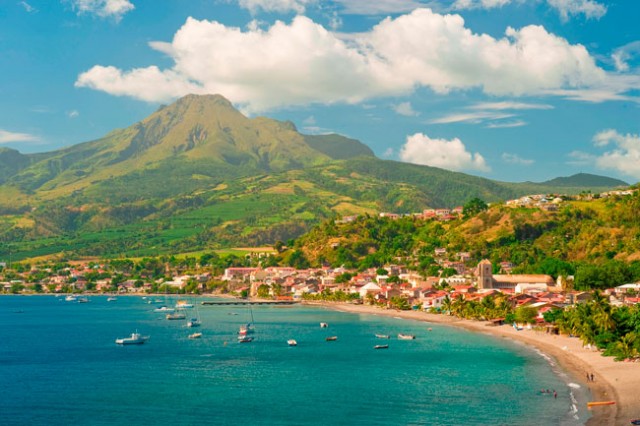Martinique
MARTINIQUE, IN the CARIBBEAN SEA, is one of the four French overseas departments and regions. Temperatures range from 25 to 30 degrees C (76 to 86 degrees F) and the climate is tropical and humid. The dry season runs from December to May (careme). Drought is relatively common from February to April. During the rainy season (hivernage), June to November, temperatures generally rise. Martinique's climate is tempered by trade winds but cyclones or hurricanes can be quite frequent.
The highest point in Martinique is Mount Pelee in the north, a live volcano that last erupted in 1902 and destroyed St. Pierre, which then was a busy port town: 30,000 were killed in the eruption. Mount Pelee is today under constant surveillance. The north is mountainous and precipitation is high. Low hills (mornes) characterize the rest of the island, except for the flat Lamentin area on the west coast where the airport is situated.

Christopher Columbus discovered Martinique in 1502. The island was colonized by the French in 1635 and in spite of spells of British occupation in 1762 and during the Napoleonic Wars (1794–1802), the island remained a French possession. The bulk of today's black and mulatto population is descended from the slaves imported into Martinique to labor on the sugar plantations. East Indians and some Chinese and Lebanese also contribute to the diversity of the population. Slavery was abolished in 1848 and the colony became a French department in 1946 after a campaign led by one of Martinique's most well-known figures, Aime Cesaire. The island became a region in 1982. As such, Martinique is a member of the EUROPEAN UNION. The official language is French, but French Creole is spoken by the mainly black and metis population. Most Martinicans are Roman Catholics.
Martinique enjoys the same advantages as any other mainland French department or region in terms of health, education, and social welfare. The islands also benefit from special measures aimed at encouraging economic development (lower income tax for example). Martinique has a General Council (Conseil General) and a Regional Council (Conseil Regional). The General Council has 45 elected members, one from each constituency, and the Regional Council has 41 members. Both councils elect their respective presidents. The Martinicans elect three deputies to the French National Assembly and two senators to the French Senate.
The president of FRANCE appoints a prefect (prefet), who then becomes the official representative of the French government in Martinique. The prefect is responsible for public order and safety and ensures that civil liberties are properly respected, but he/she does not exercise executive power, which is in the hands of the two councils. The principal export is fruit (mainly bananas). Sugarcane is grown on the island; rum is a derivative and distilled on site. The islands are also popular holiday destinations for the French and tourism represents 7 percent of the gross domestic product.
Nevertheless, government subsidies are essential to Martinique's economic survival. The island imports far more (mainly from France) than it exports (mainly to France). Unemployment is high; in 2002 one in four persons was out of work compared to approximately one in 10 in metropolitan France.